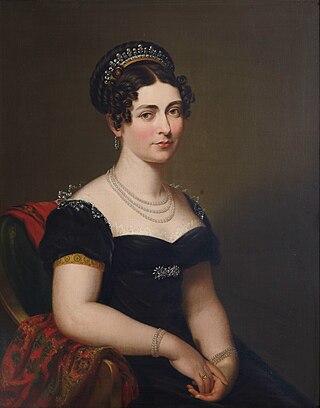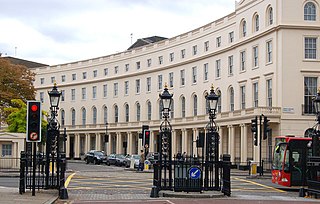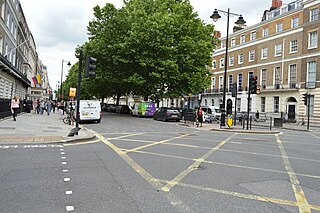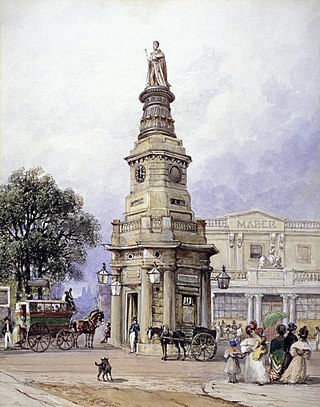
Prince Edward, Duke of Kent and Strathearn was the fourth son and fifth child of King George III and Queen Charlotte. His only child, Victoria, became Queen of the United Kingdom 17 years after his death.

Prince Arthur, Duke of Connaught and Strathearn was the seventh child and third son of Queen Victoria of the United Kingdom and Prince Albert of Saxe-Coburg and Gotha. He served as Governor General of Canada, the tenth since Canadian Confederation and the only British prince to do so.

Frogmore is an estate within the Home Park, adjoining Windsor Castle, in Berkshire, England. It comprises 33 acres (130,000 m2), of primarily private gardens managed by the Crown Estate. It is the location of Frogmore House, a royal retreat, and Frogmore Cottage. The name derives from the preponderance of frogs which have always lived in this low-lying and marshy area near the River Thames. This area is part of the local flood plain. Its large landscaped gardens are Grade I listed on the Register of Historic Parks and Gardens.

Princess Victoria of Saxe-Coburg-Saalfeld, later Princess of Leiningen and subsequently Duchess of Kent and Strathearn, was a German princess and the mother of Queen Victoria of the United Kingdom. As the widow of Charles, Prince of Leiningen, from 1814, she served as regent of the Principality during the minority of her son from her first marriage, Karl, until her second wedding in 1818 to Prince Edward, fourth son of George III.

Duchess of Kent is the principal courtesy title used by the wife of the Duke of Kent. There have been four titles referring to Kent since the 18th century. The current duchess is Katharine, the wife of Prince Edward. He inherited the dukedom on 25 August 1942 upon the death of his father, Prince George, the fourth son of George V.

Princess Sophia of Gloucester was a great-granddaughter of King George II of Great Britain and niece of King George III.

The Waterloo Vase is a 15-foot (4.6 m) stone urn, situated in the garden of Buckingham Palace in central London. Fashioned from a single piece of Carrara marble, it was initially presented to Napoleon I, who intended to have it carved in celebration of anticipated future military victories. After the Emperor’s defeat at the Battle of Waterloo, the uncarved vase was given to the Prince Regent, later George IV. The Prince commissioned the sculptor, Richard Westmacott to decorate the vase with reliefs celebrating the victory at Waterloo. The original plan to place the vase in the Waterloo Gallery at Windsor Castle proved unrealisable, the weight of the vase being greater than the gallery’s floors could bear. It was therefore given to the National Gallery in Trafalgar Square. Considering the vase surplus to its requirements, the gallery placed it first in Hyde Park, London and then into storage at the Victoria and Albert Museum. In 1903, it was offered by the museum to the new king, Edward VII, who installed it as a garden ornament in the grounds of Buckingham Palace, where it remains. The vase is a Grade I listed structure.

The parentage of Queen Victoria has been the subject of speculation. It has been suggested that her biological father was not Prince Edward, Duke of Kent and Strathearn. This suggestion has largely centred on the familial incidence of hereditary diseases and circumstantial evidence, and is not widely believed.

Coade stone or Lithodipyra or Lithodipra is stoneware that was often described as an artificial stone in the late 18th and early 19th centuries. It was used for moulding neoclassical statues, architectural decorations and garden ornaments of the highest quality that remain virtually weatherproof today.

The Royal Burial Ground is a cemetery used by the British royal family. Consecrated on 23 October 1928 by the Bishop of Oxford, it is adjacent to the Royal Mausoleum, which was built in 1862 to house the tomb of Queen Victoria and Prince Albert. The burial ground lies on the Frogmore estate within the Home Park at Windsor, in the English county of Berkshire.

Park Crescent is at the north end of Portland Place and south of Marylebone Road in London. The crescent consists of elegant stuccoed terraced houses by the architect John Nash, which form a semicircle. The crescent is part of Nash's and wider town-planning visions of Roman-inspired imperial West End approaches to Regent's Park. It was originally conceived as a circus (circle) to be named Regent's Circus but instead Park Square was built to the north. The only buildings on the Regent's Park side of the square are small garden buildings, enabling higher floors of the Park Crescent buildings to have a longer, green northern view.

St George's Chapel at Windsor Castle in England is a castle chapel built in the late-medieval Perpendicular Gothic style. It is a Royal Peculiar, and the Chapel of the Order of the Garter. St George's Chapel was founded in the 14th century by King Edward III and extensively enlarged in the late 15th century. It is located in the Lower Ward of the castle.

Portland Place is a street in the Marylebone district of central London. Named after the 3rd Duke of Portland, the unusually wide street is home to the BBC's headquarters Broadcasting House, the Chinese and Polish embassies, the Royal Institute of British Architects and numerous residential mansion blocks.
Sebastian Gahagan was a sculptor of Irish descent active in London. His most notable works are the monument to Sir Thomas Picton in St Paul's Cathedral, and a statue of the Duke of Kent in Park Crescent, Portland Place. He was also employed by Joseph Nollekens, carrying out the carving of many of his major works.

The equestrian statue of Prince George, Duke of Cambridge is a life-size memorial by Adrian Jones, installed in Whitehall, London, England.

The Joseph Lister Memorial is a memorial to Joseph Lister, 1st Baron Lister by the sculptor Thomas Brock, situated in Portland Place in Marylebone, London. The memorial is positioned in the centre of the road opposite numbers 71 to 81 and is Grade II listed. It is close to Lister's home at 12 Park Crescent.

The Thames Ditton Foundry was a foundry in Thames Ditton, Surrey, which operated from 1874 to 1939 and which under various owners produced numerous major statues and monuments as one of the United Kingdom's leading firms of bronze founders.

King's Cross was a short-lived building in London which gave its name to the area still known as Kings Cross. The building was erected in 1830, as the base for a memorial to the recently deceased King George IV. A statue of the late king was added in 1835, but then removed in 1842, and the structure was demolished in 1845.
This is a list of the etymology of street names in the area of Regent's Park in London ; the area has no formal boundaries, though it generally thought to be delimited by Prince Albert Road to the north, Park Village East and Hampstead Road/the Euston railway line/Eversholt Street to the east, Euston Road and Marylebone Road to the south and Park Road and Baker Street to the west.


















